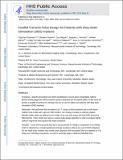Parallel transmit pulse design for patients with deep brain stimulation implants
Author(s)
Guerin, Bastien; Akgun, Can; Martin, Adrian; Torrado-Carvajal, Angel; Malpica, Norberto; Hernandez-Tamames, Juan A.; Schiavi, Emanuele; Eryaman, Yigitcan; Lopez Herraiz, Joaquin; Adalsteinsson, Elfar; Wald, Lawrence; ... Show more Show less
DownloadParallel transmit pulse.pdf (701.6Kb)
OPEN_ACCESS_POLICY
Open Access Policy
Creative Commons Attribution-Noncommercial-Share Alike
Terms of use
Metadata
Show full item recordAbstract
Purpose
Specific absorption rate (SAR) amplification around active implantable medical devices during diagnostic MRI procedures poses a potential risk for patient safety. In this study, we present a parallel transmit (pTx) strategy that can be used to safely scan patients with deep brain stimulation (DBS) implants.
Methods
We performed electromagnetic simulations at 3T using a uniform phantom and a multitissue realistic head model with a generic DBS implant. Our strategy is based on using implant-friendly modes, which are defined as the modes of an array that reduce the local SAR around the DBS lead tip. These modes are used in a spokes pulse design algorithm in order to produce highly uniform magnitude least-squares flip angle excitations.
Results
Local SAR (1 g) at the lead tip is reduced below 0.1 W/kg compared with 31.2 W/kg, which is obtained by a simple quadrature birdcage excitation without any sort of SAR mitigation. For the multitissue realistic head model, peak 10 g local SAR and global SAR are obtained as 4.52 W/kg and 0.48 W/kg, respectively. A uniform axial flip angle is also obtained (NRMSE <3%).
Conclusion
Parallel transmit arrays can be used to generate implant-friendly modes and to reduce SAR around DBS implants while constraining peak local SAR and global SAR and maximizing flip angle homogeneity. Magn Reson Med 73:1896–1903, 2015.
Date issued
2015-04Department
Institute for Medical Engineering and Science; Harvard University--MIT Division of Health Sciences and Technology; Massachusetts Institute of Technology. Department of Electrical Engineering and Computer Science; Massachusetts Institute of Technology. Research Laboratory of ElectronicsJournal
Magnetic Resonance in Medicine
Publisher
Wiley Blackwell
Citation
Eryaman, Yigitcan; Guerin, Bastien; Akgun, Can et al. “Parallel Transmit Pulse Design for Patients with Deep Brain Stimulation Implants.” Magnetic Resonance in Medicine 73, 5 (June 2014): 1896–1903 © 2014 Wiley Periodicals, Inc
Version: Author's final manuscript
ISSN
0740-3194
1522-2594